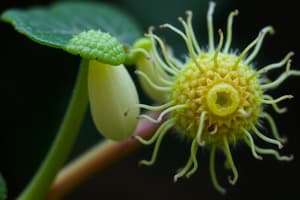Podcast
Questions and Answers
What is the primary characteristic of living organisms related to reproduction?
What is the primary characteristic of living organisms related to reproduction?
- The ability to produce energy
- The ability to adapt to environments
- The ability to grow and develop
- The ability to reproduce (correct)
What is formed as a result of fertilization during sexual reproduction?
What is formed as a result of fertilization during sexual reproduction?
- A mature organism
- A zygote (correct)
- A gamete
- A clone
Which type of reproduction requires fertilization?
Which type of reproduction requires fertilization?
- Asexual reproduction
- Budding
- Vegetative propagation
- Sexual reproduction (correct)
In which organisms is asexual reproduction commonly found?
In which organisms is asexual reproduction commonly found?
Which of the following best describes a zygote?
Which of the following best describes a zygote?
What process do prokaryotic cells utilize for division?
What process do prokaryotic cells utilize for division?
What is the main source of origin for all the cells in our body?
What is the main source of origin for all the cells in our body?
In eukaryotic organisms, what does the cell cycle consist of?
In eukaryotic organisms, what does the cell cycle consist of?
Which of the following is NOT a characteristic of eukaryotic cell division?
Which of the following is NOT a characteristic of eukaryotic cell division?
What is the significance of pre-existing cells in cell division?
What is the significance of pre-existing cells in cell division?
Flashcards are hidden until you start studying
Study Notes
Reproduction in Living Organisms
- Reproduction is a fundamental characteristic of all living organisms.
- Reproduction can occur asexually in unicellular organisms or sexually in multicellular organisms.
- Sexual reproduction involves the fusion of two gametes (sex cells) to form a zygote.
- The zygote is a fertilized egg cell that develops into a new organism.
Cell Division
- All cells originate from pre-existing cells through a process known as cell division.
- In prokaryotes, cell division occurs through binary fission, a simple process where the cell replicates its DNA and divides into two identical daughter cells.
- Eukaryotic cell division is more complex and occurs in two distinct phases: interphase and the mitotic phase.
Studying That Suits You
Use AI to generate personalized quizzes and flashcards to suit your learning preferences.




